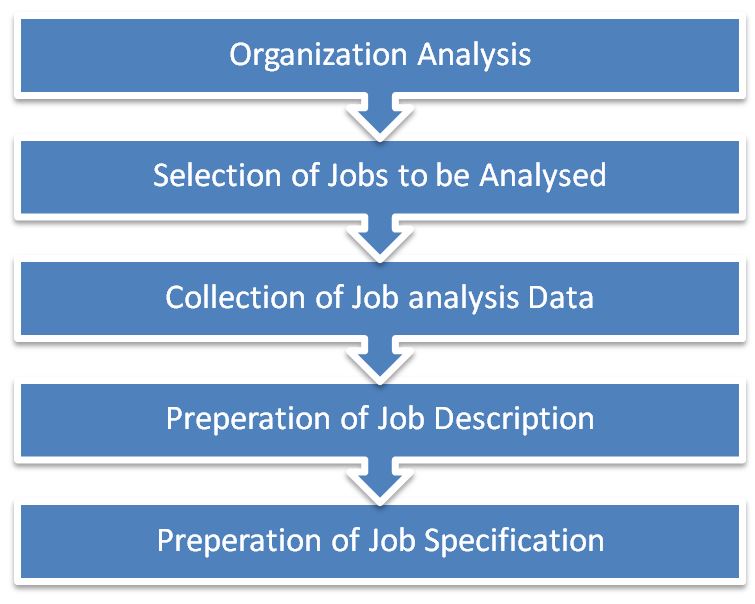A job is a collection of tasks, duties and responsibilities necessary to be performed to achieve organizational objectives. Therefore, Job Analysis may be defined as a systematic investigation of tasks, duties, responsibilities necessary to do a job.
Task – Identifiable work for a specific action
Duties – Sequence of tasks to be performed
Responsibilities – Obligation to perform tasks and duties
According to Edwin B. Flippo, “Job Analysis is the process of studying and collecting information relating to the operations and responsibilities of specific job”
Information Provided by Job analysis –
- Job Identification – Job Title, Code no.
- Characteristics of the job – Location, Physical setting
- What a typical worker does?
- What materials and machines a worker uses?
- How the Job is performed?
- Required personal attributes?
- Job relations – Relation with superior, junior, co-worker, counsellor
Sources of Information for Job Analysis –
- Employees performing the Job
- Supervisors and Managers
- Outside Analysts
Methods of Job Analysis –
- Job Performance
- Personal Observation
- Critical Incidents
- Interview
- Panel of Experts
- Diary/Log Method
- Questionnaire – PAQ – Post Analysis Questionnaire, FJA – Functional Job Analysis, MPDQ – Management Position Description Questionnaire
Process of Job Analysis –
Uses of Job Analysis –
- Human Resource Planning
- Recruitment, Selection and Placement
- Induction and Orientation
- Job Design and Redesign
- Job Evaluation
- Compensation and Benefits
- Performance Appraisal of Employees
- Training and Development of Employees
- Re-engineering – Combining specialized jobs, Division of responsibility and authority, making work more challenging etc.
Outcomes of Job Analysis
- Job Description
- Job Specification
Job Description – It is a written statement of what a job holder expected to do, how it is done, under what conditions and why it is done.
It is a descriptive statement with written record of tasks, duties and responsibilities of a particular job.
According to M.W. Cuming, “A job description is a broad statement of the purpose, scope, duties and responsibilities of a particular job.”
Information provided by Job description –
- Job Identification – Job Title, Code no., Department
- Job Summary – Primary/Secondary Duties and Tasks to be performed
- Job Activities – List of Duties, Frequency of work, Time involvement
- Relation to Other Jobs – Horizontal and vertical relationships of work and procedures
- Supervision – Type of Supervision – General, Intermediate or Close supervision, Extent of Supervision
- Working Conditions – Heat, Cold, Light, Noise, risk to life and other hazards
- Social Environment – Size of workgroup, Social Interactions
Purpose of Job Description –
- Attract candidates
- Collect job related data
- To understand what is to be done in order to achieve Job objectives
- To understand how job is to be performed
- To understand who will do the job and under what conditions
- To determine the type and extent of supervision the worker will be put under
- To set working standards and safety standards
- To prepare Job specification
Job Specification – It translates the Job Description into terms of human qualities and qualifications which are required for successful performance of a job.
According to Edwin B. Flippo, “A Job Specification is a statement of minimum acceptable human qualities necessary to perform a job properly.”
It includes a summary of attributes required in a person to be chosen for a particular job. These attributes may be divided into three categories –
- Essential Attributes – Skills, Knowledge and Abilities (SKA) a person must possess for successful job performance.
- Desirable Attributes – Attributes a person ought to possess.
- Contra-Indicators – Attributes that will hinder job performance.
They Relate to –
- Physical Characteristics – Physique, Body size, Health, Strength, Height, weight, vision etc.
- Demographic Characteristics – Age, Sex, Education, Experience, Location, Language, Religion etc.
- Psychological Characteristics – Aptitude, Manual dexterity, Mechanical Aptitude, Judgement, Mental concentration, Analytical ability
- Personal Traits – Appearance, Manners, Voice, Emotional Stability, Extroversion, Aggressiveness, Leadership Qualities, Loyalty
- Social Characteristics – Extroversion, Adaptability to human relationships, Cooperativeness, Views towards society
- Responsibilities – Responsibilities of supervision, achieving targets, meeting deadlines, safety of others, discipline

if possible make the notes available to be downloaded or copied cause their good notes